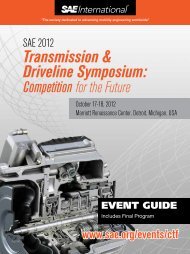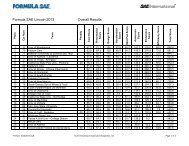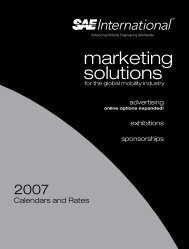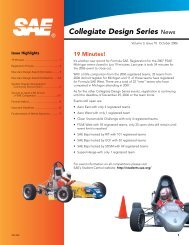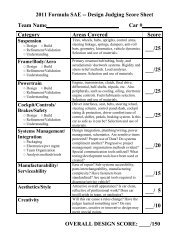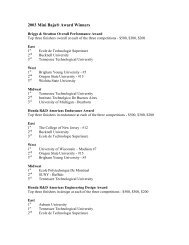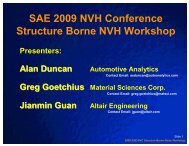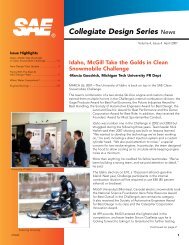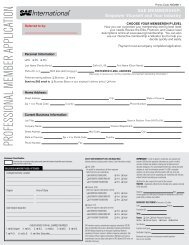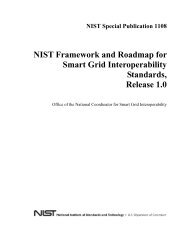The 4T50ME-GI Test Engine at MAN Diesel & Turbo's ... - Sae.org
The 4T50ME-GI Test Engine at MAN Diesel & Turbo's ... - Sae.org
The 4T50ME-GI Test Engine at MAN Diesel & Turbo's ... - Sae.org
Create successful ePaper yourself
Turn your PDF publications into a flip-book with our unique Google optimized e-Paper software.
7 Potential Applic<strong>at</strong>ions for ME-<strong>GI</strong><br />
<strong>Engine</strong>s<br />
As previously mentioned, the ME-<strong>GI</strong><br />
engines – originally design<strong>at</strong>ed MC-<strong>GI</strong><br />
– were developed for LNG carrier pro-<br />
pulsion. In the project phase, the ME-<strong>GI</strong><br />
was recommended for the now-famous<br />
45-strong Q<strong>at</strong>argas fleet of Q-Flex and<br />
Q-Max LNG carriers built for the mas-<br />
sive expansion of gas export<strong>at</strong>ion from<br />
Q<strong>at</strong>ar in the Persian Gulf.<br />
However, the shipowner selected<br />
the heavy fuel variant and, accord-<br />
ingly, each of these vessels has 2 × 6<br />
7S70ME-C HFO engines installed. In<br />
the meantime, the rel<strong>at</strong>ive pricing of gas<br />
and fuel has changed in some parts of<br />
the world and a retrofit project is now in<br />
the shaping, with some of these vessels<br />
as candid<strong>at</strong>es for retrofit to 2 x 6 type<br />
7S70ME-<strong>GI</strong>.<br />
<strong>The</strong>se vessels already have a relique-<br />
faction plant on board so therefore the<br />
gas-supply train to the engines fe<strong>at</strong>ures<br />
a cryogenic pump/evapor<strong>at</strong>or. It is es-<br />
tim<strong>at</strong>ed th<strong>at</strong> such a retrofit install<strong>at</strong>ion<br />
would take about one year to prepare,<br />
followed by 4 - 6 weeks re-building,<br />
which typically would take place during<br />
a regular survey docking. Fig. 16 shows<br />
a Gant diagram for such a conversion.<br />
<strong>The</strong> ME-<strong>GI</strong> engine can also be seen as<br />
a way of simultaneously meeting Tier-III<br />
emission limits and fuel-sulphur con-<br />
tents/SO x emission limits. With n<strong>at</strong>ural<br />
gas being sulphur free, SO x emissions<br />
from an ME-<strong>GI</strong> engine are limited to th<strong>at</strong><br />
emitted by the burning of pilot oil.<br />
<strong>The</strong> extremely low SO x emissions from<br />
an ME-<strong>GI</strong> engine also facilit<strong>at</strong>e the nec-<br />
<strong>MAN</strong> B&W <strong>Diesel</strong><br />
essary Tier-III NO x control ab<strong>at</strong>ement<br />
methods for two-stroke engines, SCR<br />
( Selective C<strong>at</strong>alytic Reduction ) and<br />
EGR (Exhaust Gas Recircul<strong>at</strong>ion ). For<br />
SCR, the SO x in the exhaust limits the<br />
temper<strong>at</strong>ure regime in which the reac-<br />
tion can take place while for EGR, the<br />
exhaust gas to be recircul<strong>at</strong>ed needs to<br />
be cleaned and cooled before returning<br />
to the engine. This is obviously much<br />
cleaner when derived from an ME-<strong>GI</strong><br />
combustion. <strong>The</strong>refore, an ME-<strong>GI</strong> en-<br />
gine with SCR or EGR could constitute<br />
a Tier-III, low-speed engine as an alter-<br />
n<strong>at</strong>ive to an ME-type HFO engine with<br />
SCR or EGR and SO X scrubber.<br />
<strong>The</strong> fact th<strong>at</strong> n<strong>at</strong>ural gas is generally<br />
cheaper than HFO on a calorific input<br />
basis, while low-sulphur or even sul-<br />
phur-free fuels are significantly more ex-<br />
pensive than HFO, supports the use of<br />
ME-<strong>GI</strong> engines.<br />
<strong>The</strong> regul<strong>at</strong>ory environment is practical-<br />
ly in order already and the logistics for<br />
running on gas will come with demand.<br />
Accordingly, advanced shipbuilders –<br />
particularly in Japan and Korea – are<br />
already marketing containerships, tank-<br />
ers and bulk carriers powered by ME-<br />
<strong>GI</strong> engines. Bringing development one<br />
step further, <strong>MAN</strong> <strong>Diesel</strong> &Turbo has<br />
recently also decided to advoc<strong>at</strong>e the<br />
use of LPG and other VOCs (Vol<strong>at</strong>ile<br />
Organic Compounds) in a variant of the<br />
ME-<strong>GI</strong> engine. This will be design<strong>at</strong>ed<br />
ME-L<strong>GI</strong> (for Liquid Gas Injection). While<br />
the ME-<strong>GI</strong> probably will be used mostly<br />
in larger vessels on longer routes, the<br />
ME-L<strong>GI</strong> will be used more predomi-<br />
nantly in short-sea shipping due to the<br />
easier logistics offered by LPG/VOC.<br />
Conclusion<br />
<strong>The</strong>re is plenty of gas available in the<br />
world, with some sources evalu<strong>at</strong>ing its<br />
reserves as even gre<strong>at</strong>er than oil. <strong>The</strong><br />
main drivers for using gas <strong>at</strong> sea are<br />
first and foremost environmental con-<br />
sider<strong>at</strong>ions – including a gre<strong>at</strong> reduction<br />
in CO2 emissions – but the cost of the<br />
various fuel types are also an important<br />
factor. <strong>MAN</strong> <strong>Diesel</strong> & Turbo sees gre<strong>at</strong><br />
potential in the use of gas aboard ships<br />
and is alloc<strong>at</strong>ing substantial research<br />
efforts towards developing suitable<br />
technologies to this end.<br />
<strong>The</strong> <strong>4T50ME</strong>-<strong>GI</strong> <strong>Test</strong> <strong>Engine</strong> <strong>at</strong> <strong>MAN</strong> <strong>Diesel</strong> & Turbo’s Copenhagen <strong>Test</strong> Centre<br />
18



